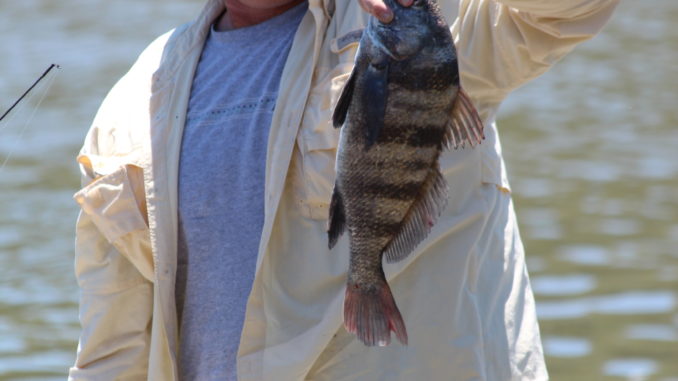
Two Civil War-era wrecks in Inlet are holding a lot of black drum
Black drum are biting in Lockwood Folly Inlet near Holden Beach, and according to Fayetteville’s Daniel McJunkin, as long as you can find the two wrecks in the inlet, you’ll find the black drum.
Recent dredging by the U.S. Army Corps of Engineers has made it a little more difficult to spot the two Civil War shipwrecks, but parts of them are visible at low tide, and they are easy to find with a boat’s depth finder.
“The rising tide is the best, and you can use the tide to your advantage when casting. As the tide comes in, you can cast away from the wreck, and the current will carry your bait up to the edge of it,” said McJunkin. “Sand fleas are easy to dig up on the beaches here, but cut shrimp is working, too.”
McJunkin said it’s best to have multiple rods rigged up when fishing the wrecks.
“You’re going to get hung up and break your line,” he said. “That’s just the nature of fishing on a wreck. If you’re constantly having to retie, you’re losing valuable fishing time, especially when fishing here, because you want to be able to see as much of the wreck with the naked eye as you can, and as the tide comes in, you see less and less of it.”
McJunkin likes to fish with 2500 series spinning reels, and he uses 17-pound-test monofilament.
“I wouldn’t use braided line here, because when you get snagged in the wreck, you’re going to have a hard time breaking your line. And if you have to cut it, you’re going to lose a lot of line,” said McJunkin, who uses 3/0 hooks and just enough weight to get the bait down.
“I don’t necessarily want it to stay anchored, because I want the current to be able to carry it into the edges of the wreck, but I do want it on the bottom,” he said. A ¾-ounce weight is usually enough.
Once the bait sinks, McJunkin keeps his line tight and just feels for a nibble. He’ll reel in slowly if he isn’t getting bit, but he will move it just a few inches at a time, then let it sit again.
“Some days, these fish are picky and will seem to only hit the bait in just the right spot. As long as you’re moving it really slow, they will still bite once it gets to that spot,” he said.
McJunkin said the bite is often fast, and it ends quickly once the tide is in.
“It’s hectic because you’ve got to get it while the getting is good. They’ll bite steady while the tide is coming in, and they are easier to find. Once that’s over, it gets tough,” he said.
Anchoring is a big part of fishing here, according to McJunkin, who suggests anglers arrive with plenty of time to anchor and not be afraid to pull and reset the anchor if they aren’t happy with their first, second, or third try.
“If you can’t cast in a way that allows the current to put your bait up against the edge of those wrecks, you might as well be fishing open water,” he said.




